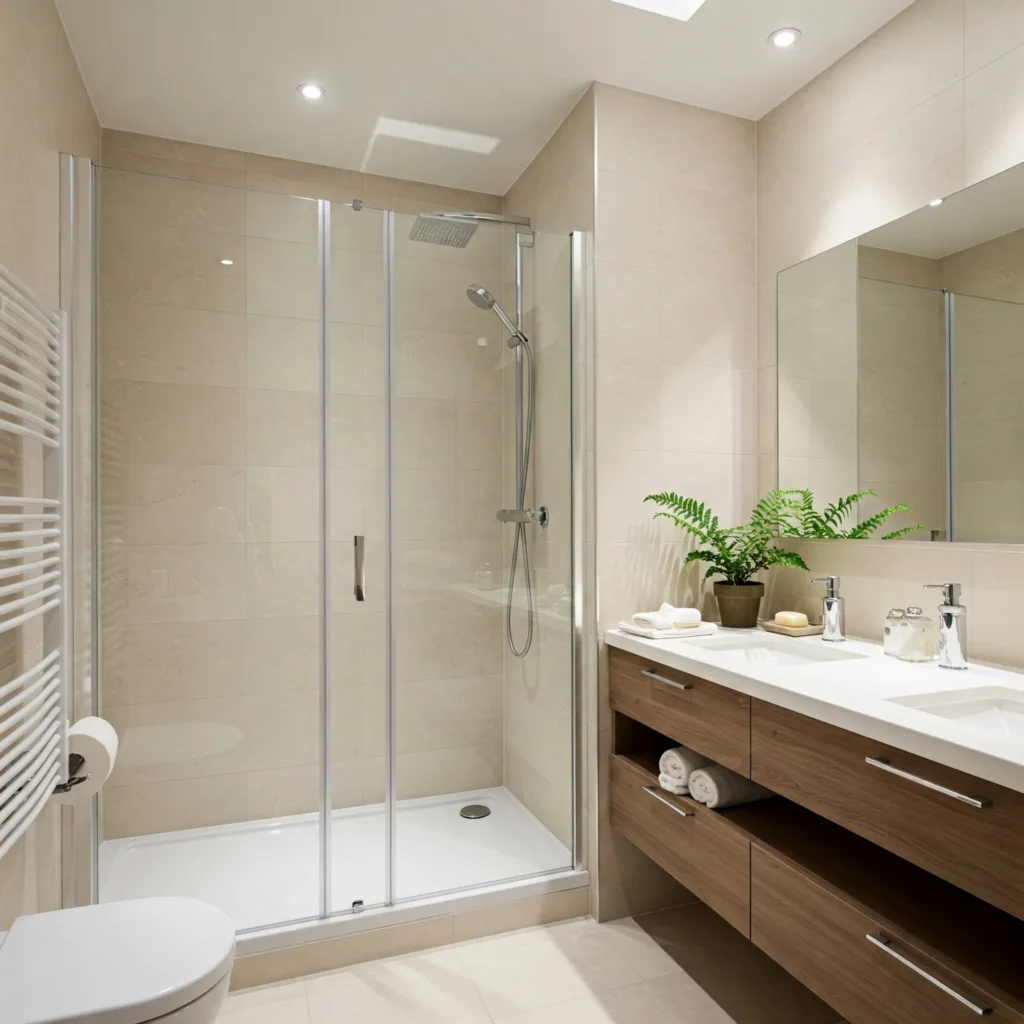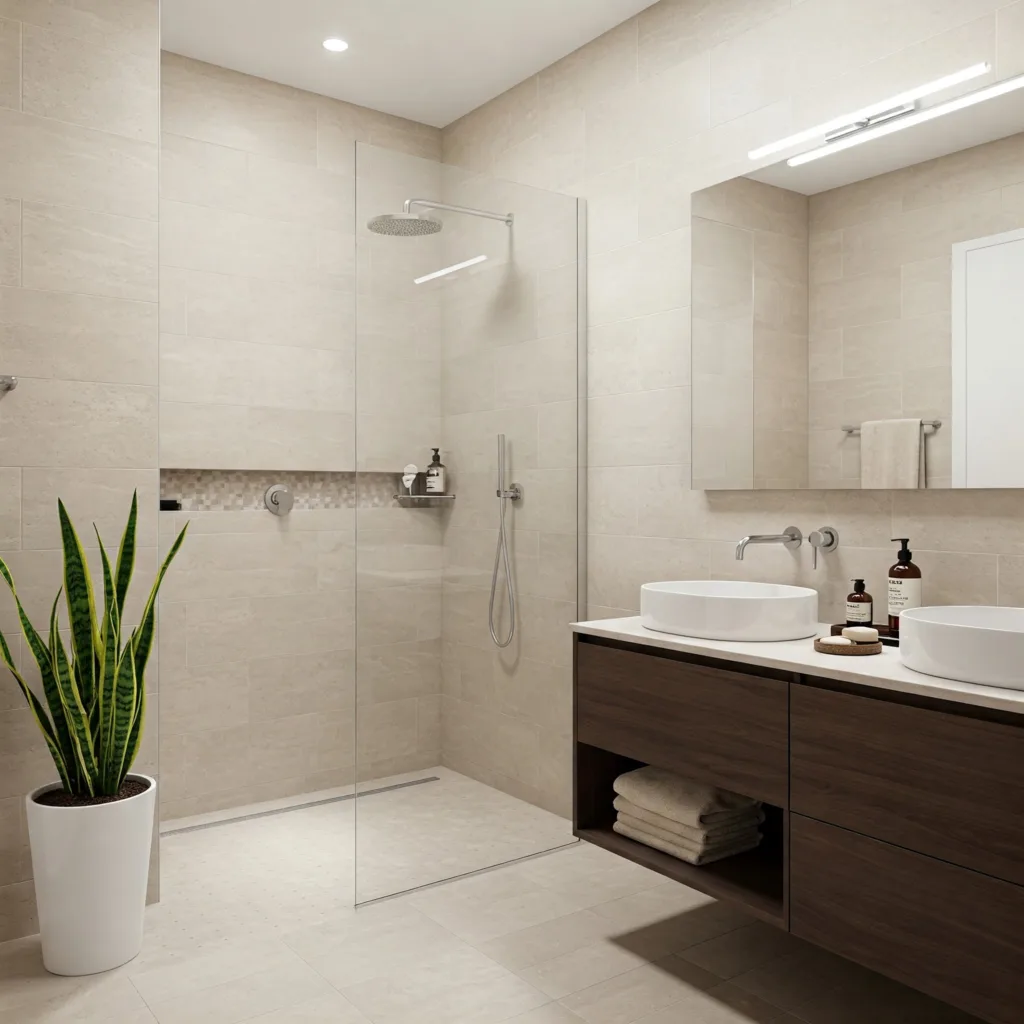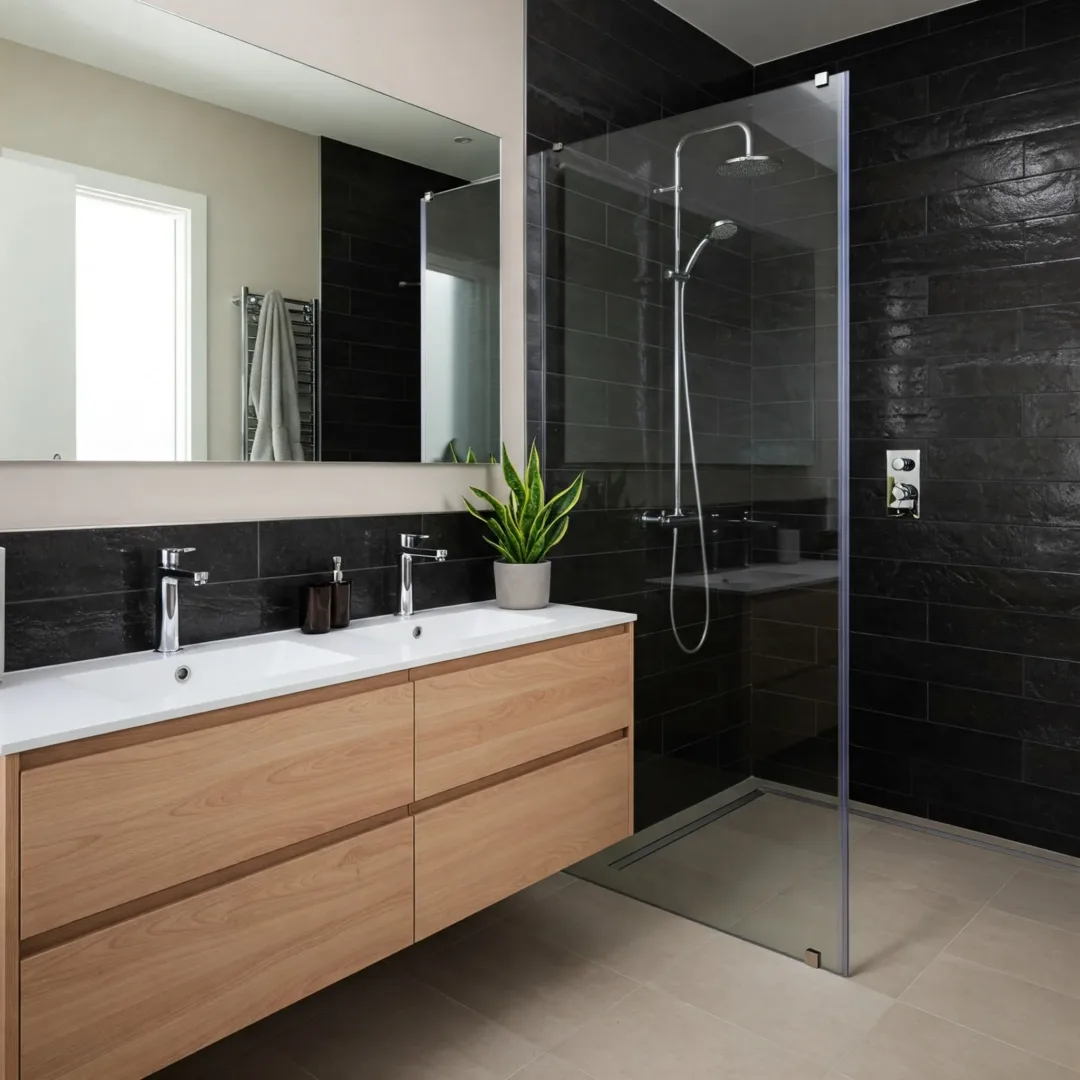Traditional vs. Walk – In Shower: What’s the Difference?
Thinking about a bathroom upgrade? You might wonder about classic vs. a walk in shower.
What about materials? What shower dimensions work best? And the cost? We’ll guide you to create the ideal space for your dream bathroom.
Table of contents
Understanding the Core Differences: Walk – In Shower vs. Traditional
Curious about the main differences? Let’s explore traditional and walk – in shower options.
The Traditional Shower: Simple and Familiar
A traditional shower has a raised tray or shower pan on the floor. Common materials include acrylic, resin, or enameled stoneware.
This design needs a small step for drainage. They come in various shapes and shower dimensions to fit different bathrooms. Installation is usually straightforward and budget-friendly.
The Walk in Shower: Modern Design and Easy Access
Designers build the walk – in shower, or Italian shower, directly into the floor. Without a tray, so the floor requires a slope for drainage.
Installing it requires more effort and money, but it gives a modern, elegant feel. Glass panels often help contain water. Best of all, it’s easy to get into for people with limited mobility because there’s no step.
A traditional shower is an easy and classic solution. A walk-in shower offers better access and a modern feel, but it’s more involved to install. Whatever your choice, you will find the solution that meets your needs and style!


Experience the Difference: Walk-in Shower Benefits
Walk-in showers offer a unique bathing experience full of benefits. Here’s why they have become the ideal choice for many people:
Aesthetics and Personalization
The walk-in shower is a true jewel of modern design. It brings a sophisticated charm to the bathroom thanks to its clean and elegant design. But what makes it truly unique is its ability to adapt to your personal tastes and styles. You can change the size, look, materials, and colors to create a space that’s exactly your style.
Space and Comfort
Without a door or tray, the walk-in shower offers an open space that allows for increased freedom of movement. This is particularly advantageous in smaller bathrooms, where every inch counts. Seniors appreciate this freedom of movement, which allows them to feel more comfortable and safe.
Easy Maintenance
Glass or tile walls not only look elegant but also clean very easily. This significantly reduces the risk of mold and simplifies daily maintenance. You can easily enjoy a clean and hygienic shower.
Durability
Walk-in showers use fewer parts than traditional showers, which makes them more durable and less prone to breakdowns. It’s a smart choice for those looking to minimize repairs and maximize the longevity of their installation.
Accessibility and Safety
Imagine a shower where access is easy for everyone, without a threshold or step. This is exactly what the walk-in shower offers, ideal for the elderly or those with reduced mobility. The absence of a ledge allows for safe entry and exit, significantly reducing the risk of falls. It is a real asset to preserve the autonomy and confidence of users.
But to really enjoy these advantages, it’s important to install it carefully. This will keep water from leaking and causing problems. With proper installation, the walk-in shower becomes a true haven of comfort and safety in your bathroom.
Choosing the Perfect Materials for a Walk-in Shower: A Warm and Practical Guide
Your choice of materials for a walk-in shower ensures a space that’s useful, elegant, and welcoming. Here are some top materials for this type of shower. We choose them because they resist water, are easy to clean, and look good.
Materials for the Floor
- Tiles: This is the most popular material for the floor of a walk-in shower. Available in a multitude of styles, formats and colors, it is waterproof, non-slip and easy to clean. It is the ideal option to create a visual continuity with the rest of the bathroom.
- Porcelain stoneware: This material is tough and can fit many styles. Manufacturers can make it look like stone, marble, or even wood, giving you a lot of design choices.
- Mosaic: more complex to install, but it adds a unique decorative element that can make your shower a masterpiece.
- Natural stone: It brings an authentic charm and exceptional longevity. Its weight requires precautions during installation.
- Exotic wood: can give a natural touch, but make sure it’s waterproof to prevent problems.
Wall materials
- Glass: This is the most popular material for walk-in shower walls. Available in clear, patterned, or mirrored styles, it’s easy to clean and makes the space look bigger because you can see through it.
- Ceramic: is also popular because it looks nice and is easy to clean, making it ideal for a walk-in shower.
- Synthetic materials : Acrylic and PVC are cheaper options. You can also change them to match your style.
Other Materials
- Waxed concrete: It can be used for the floor or walls, offering a modern and resistant look. It is an excellent option for those looking for a contemporary style.
- Gel-coated resin concrete: Perfect for shower trays, it’s a good value and provides a smooth, durable finish.
In short, tiles are the most popular for floors, and glass for walls. These materials make your bathroom look good and are durable and easy to maintain. Letting you fully enjoy your walk-in shower.

Here are some tips for choosing the ideal dimensions for a walk-in shower.
For a walk-in shower, think carefully about where it will fit in your bathroom and how much room you have. The standard dimensions for a walk-in shower vary, but here are some common sizes that might inspire you:
- 31.5″ x 47.2″ – Fits most bathrooms, offers good space balance.
- 35.4″ x 39.4″ – Slightly wider, more comfort without occupied too much space.
- 35.4″ x 35.4″ – A compact square that still feels roomy.
- Up to 78.7″ in length – Best for large or custom-built bathrooms.

Picking the right size for your space
It’s really important to pick a size that works for the space you’ve got in your bathroom and for you. Most people find that a width of 90 cm or more is the best fit. Got a small bathroom? Here are some tips for fitting in a walk-in shower that’s both nice and useful.
Tips for Optimizing Small Space
Location Choice:
- Installation in a corner: It saves space and uses a glass wall to contain water in the shower area.
- Use of every nook and cranny: Even awkward spaces can work by shaping the shower to the curved wall.
Space Optimization:
- Compact shower: Opt for shower dimensions such as 31.5 to 35.4 inches wide and 47.2 inches long for a small space.
- Use of glass: Glass walls or transparent shower screens can visually enlarge the space and reduce splashing.
Design and Materials:
- Continuous tiling: Extending the bathroom tiling into the shower creates a visual continuity that enlarges the space.
- Non-slip materials: Use non-slip flooring materials to ensure safety.
Technical Installation:
- Floor preparation: Make sure the floor is leveled and sloped for proper water drainage.
- Waterproofing: Use waterproof membranes to prevent water infiltration.
Furniture and Storage:
- Minimalist furniture: Use minimalist bathroom furniture that combines sink and storage to maximize space.
- Vertical storage: Take advantage of vertical space with narrow and tall cabinets to store towels and other accessories.
By following these tips, you can create a functional and aesthetic walk-in shower, even in a small space. Feel free to personalize your space by adding decorative elements that reflect your style and create a relaxing atmosphere.
Here’s a look at how much it costs to install and maintain a classic shower versus an Italian-style shower.
Think about the installation and upkeep costs when choosing between a traditional and a walk-in shower. The materials, installation work, and size affect the price for both.
Traditional Shower
- Installation: A traditional shower is generally simpler and less expensive to install. The cost of a shower pan can vary between $200 and $1,500, depending on the material and size. The total installation cost, including plumbing and tiling, can range from $1,000 to $3,000. It is a practical and adaptable option for most spaces, making it an economical choice.
- Maintenance: Cleaning a traditional shower is relatively easy, requiring regular maintenance to prevent mold and limescale. Repairs are often less expensive and simpler because the parts are more accessible. Maintenance is therefore relatively simple and inexpensive, with limited need for special products.
Walk-in Shower
- Installation: A walk-in shower is more complex to install, which is reflected in its cost. The average price for a complete installation is between $3,000 and $7,000. Costs include tiling, glass enclosures, faucets, and drainage systems. Installation often requires major work, such as floor preparation, waterproofing, and plumbing, which increases the cost. However, it offers a modern design and improved accessibility.
- Maintenance: Repairs in walk-in showers can be complex and costly because parts are integrated into the floor and walls. Fixing a tile leak might require floor removal. Regular maintenance is crucial to prevent waterproofing and drainage issues, saving money in the long run.
Basically, traditional showers are cheaper and easier to maintain. Walk-in showers offer modern design and better access but cost more to install and upkeep. The choice between these two options will depend on your priorities in terms of style, budget, and comfort.
In Conclusion: Choosing Between a Traditional Shower and a Walk-in Shower?
It’s a decision that depends on your priorities! A traditional shower is often more affordable to install, thanks to its simplicity and the materials used. On the other hand, the walk-in shower offers a touch of elegance and modernity that may be worth investing a little more.
Traditional showers are usually cheaper to maintain daily. Walk-in showers need regular upkeep and can have pricier repairs due to their complexity. However, their modern design and better access can make these extra costs worthwhile for some.
Make sure you’re following us on social media so you don’t miss any news.



